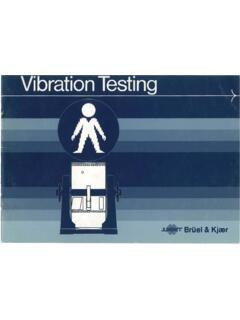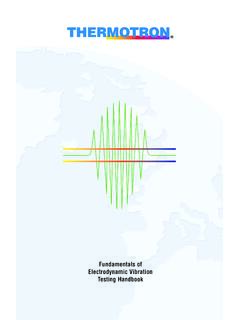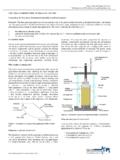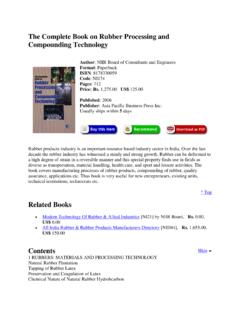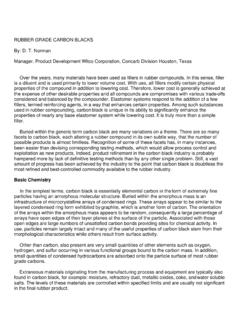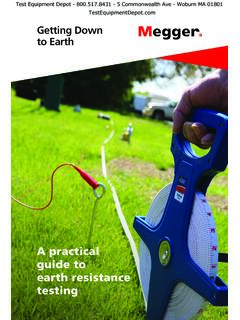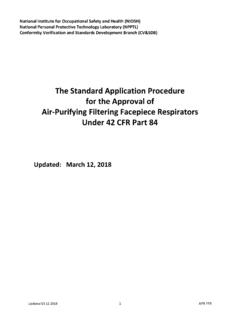Transcription of UNDERSTANDING ASTM D 2000 AND SAE J200
1 "Engineered Sealing Solutions" UNDERSTANDING ASTM D 2000 AND SAE J200 In order to provide guidance in the selection of vulcanized rubber materials, and to provide a method for specifying these materials by the use of a simple line call-out specification, the Society of Automotive Engineers (SAE) and the American Society for testing and Materials (ASTM) established SAE J200 / ASTM D 2000. Though these standards are virtually identical, J200 finds its widest use within the automotive industry, whereas D 2000 is the more common tool among rubber manufacturers. Specifying elastomers via standardized line call-outs is a good idea because it allows the flexibility of using different manufacturers' compounds while ensuring that material quality and performance remain consistent. D 2000 is based on the premise that the properties of all rubber products can be arranged into characteristic material designations.
2 These designations are determined by types, based on resistance to heat aging, and classes, based on resistance to swelling. A. The document name (ASTM D 2000-95). The two-digit number following the hyphen indicates the revision year (in this case, 1995). B. The letter "M" may or may not be present. Since it is present in our example, the units of measure in the line call-out (and in any other documentation, such as a test report) are understood to be stated in SI (metric) units. For example, tensile strength is in megapascals (MPa). If the "M" was not present, English units would be in use. For example, tensile strength would be in pounds per square inch (psi). C. The Grade Number defines specific added test requirements which are desirable in cases where the basic requirements do not always sufficiently ensure an acceptable material.
3 Grade 1 indicates that only the basic requirements are compulsory; no suffix requirements are permitted. All other grades and test requirements are listed in Table 6 of the SAE J200 / ASTM D 2000 documentation. In our example, the material is Grade 2. D. The Type is based on changes in tensile strength of not more than 30%, elongation of not more than -50%, and hardness of not more than 15 points after heat aging for 70 hours at a given temperature. The temperatures at which these materials shall be tested for determining type are listed in Table 1. In our example, the material is Type B, which corresponds to a 100 C test temperature. 757 Philhower Beloit, WI 53511 Phone: 630-595-4770 Fax: 847-273-0566 E. The Class is based on the material's resistance to swelling in Industry Reference Material (IRM) 903 Oil (now used in lieu of ASTM Oil Number 3, which was discontinued due to requirements by the Occupational Safety and Health Administration, or OSHA).
4 testing involves immersion for 70 hours at the temperature previously determined from Table 1 (100 C), after which swell is calculated. Limits of swelling for each class are shown in Table 2. In our example, the material is Class G, indicating a maximum swell of 40%. Be aware that ASTM Oil Number 3 and IRM 903 Oil are similar but not identical, so complete equivalency among results is not possible. For information on converting ASTM oil swell values to IRM values, refer to ASTM Emergency Standard ES 27-94. F. The next three digits (in this case, "714") specify the hardness and tensile strength. The first digit indicates Shore A durometer. For example, 7 for 70 5. The next two numbers indicate the minimum tensile strength. For example, 14 for 14 MPa. Remember, this will be in SI units if the letter "M" is in the call-out, and English units if not.
5 To convert to psi, simply multiply the MPa number by 145. In this case, 14 MPa would convert to 2,030 psi. G. Suffix letters and suffix numbers follow the hardness and tensile strength specifications to provide for additional testing requirements. The meaning of each suffix letter is shown in Table 3. For example, the "B" of "B14" specifies a compression set test. Suffix letters are typically followed by two suffix numbers. The first number always indicates the test method, and the second indicates the test temperature. The suffix numbers are covered by Tables 4 and 5 of the ASTM D 2000 documentation. For example, the "1" specifies a 22-hour compression set test as detailed in D 395 (Method B) for solid test specimens, and the "4" specifies testing at 100 C. Keep in mind that in some cases, the second suffix number may be two digits, which means you might see something like "F110.
6 " F110 would indicate a 3-minute low temperature resistance test as detailed in ASTM D 2137 (Method A) and conducted at a temperature of -65 C. That's really all there is to UNDERSTANDING the J200 / D 2000 call-out system. It is one of the most versatile specifications in the rubber industry. In addition to helping you specify compounds, familiarity with the J200 / D 2000 system will also help you make sense of material test reports.

